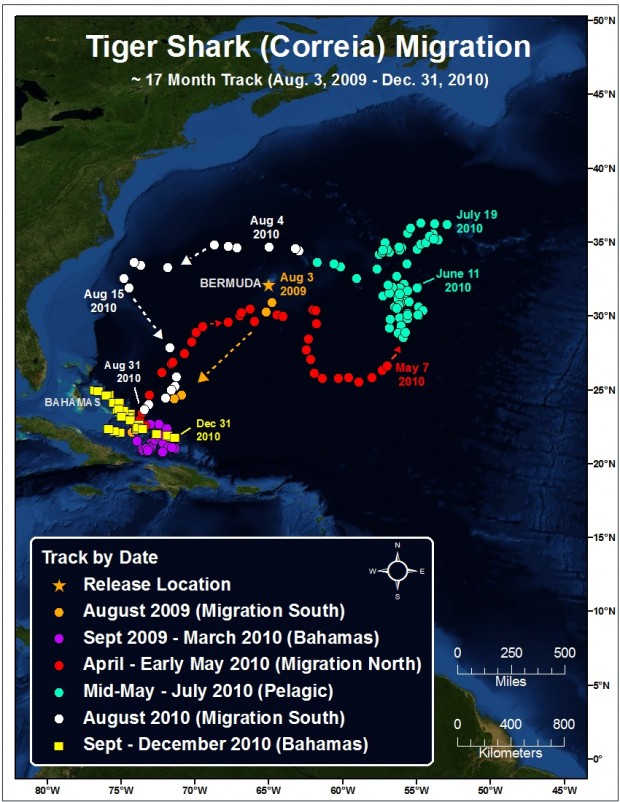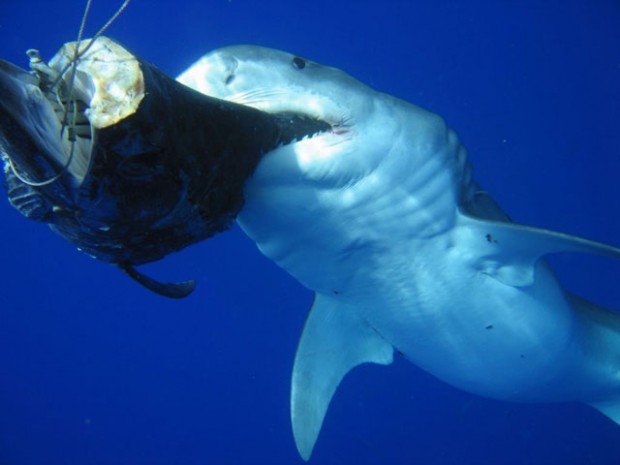Tiger Sharks: From Predators To Victims
 Tiger sharks are often classed as one of the most dangerous sharks in the ocean, sleek killing machines second only to the Great White in terms of predatory reputation.
Tiger sharks are often classed as one of the most dangerous sharks in the ocean, sleek killing machines second only to the Great White in terms of predatory reputation.
But that label is considered undeserved by members of the Bermuda Shark Project, who since 2005 have sought to de-mystify – and de-stigmatise – the elegant animal which is now being heavily overfished.
Led by veterinarian Dr. Neil Burnie and filmmaker Choy Aming, the Bermuda Shark Project tracks the movements of tiger sharks in Bermuda waters — as well as their migratory habits which often take these maligned fish as far afield as the Bahamas and the Turks & Caicos Islands.
Information collected is important to international fisheries management and conservation policies, particularly now, given the increase in finning and long-lining. In the Bahamas a campaign is underway calling for the enactment of legislation that will ban commercial shark fishing in that country.
The oceanic predator has turned victim as shark populations around the world are under threat as they are increasingly targeted for their fins to be served in the East Asian delicacy shark fin soup. The Pew Environment Group’s Global Shark Conservation Campaign, estimates 100 million sharks are killed every year, including 73 million exclusively for their fins, and the remainder as by-catch in longline fishing.
Working in conjunction with the Bermuda Shark Project, Dr. Mahmood Shivji of the Guy Harvey Research Institute — based out of the Oceanographic Centre at Florida’s Nova Southeastern University – has now tagged a dozen tiger sharks in local waters. He has found they migrate directly to the Bahamas and remain there for several months before swimming out to the mid-Atlantic and then returning to the Bahamas the following year.
“Sharks that we outfitted with satellite tags in Bermudian waters are providing exceptional information about their long-term migratory behaviour,” Dr. Shivji has said. “ We have been fortunate to be able to follow these tiger sharks for a record length of time (12-17 months and counting), and are discovering fascinating information about their seasonal movements.”
“In brief, the sharks left Bermuda in the fall of 2009 as the waters cooled and made notably direct pathways to the Bahamas or Caribbean, where they spent six-eight months in close association with island habitats.
“Then starting in the spring of 2010, the tiger sharks reversed course showing highly directed migrations northwards, moving beyond and often east of Bermuda and staying well out in the open ocean. In two instances, the batteries on the tags have lasted over 17 months and have revealed a consistent migratory pathway back to the Bahamas starting in the fall of 2010.
“What is also amazing is that after their pelagic sojourn these sharks have returned to locations in the Bahamas really close to where they were hanging out a year ago! Who gave them a GPS?”
The migratory track of Bermuda tiger shark “Correia” is shown below:
Dr. Shivji has said a critical requirement for the proper management and conservation of the tiger shark is a better understanding of its migratory patterns, how it uses its environment, and identification of what is termed its “critical habitat” – areas that are key to successful reproduction and feeding.
“And that is why the Guy Harvey Research Institute in collaboration with the Bermuda Shark Project is investigating tiger shark movements in the western North Atlantic in a long-term study,” he said. “ The sharks’ movements are being studied by employing satellite tags that relay information on where the tiger shark is and/or its depth in the ocean.
“The migratory patterns we’ve uncovered makes one wonder what the sharks are doing so far out in the Atlantic Ocean after spending approximately half a year acting like reef sharks tightly associated with island habitats …
“Something must be seasonally attracting these sharks into the deep open-ocean far offshore. We’re guessing it is not indigestible man-made garbage. Are they out in nearly the middle of the north Atlantic for two-four months for mating? For feeding on migratory prey such as turtles? It’s still an open question.
“Notably, however, these tiger sharks are displaying a remarkable ability to drastically switch their habitats comfortably, using shallow, coral reef environments for part of the year and completely open-ocean, deep environments for the other part with rapid travel in-between. Few other shark species show this flexibility in the habitats they can use.”
Based on these initial and novel findings, Dr. Shivji said reseachers are continuing this study in additional places to get a more detailed picture of tiger shark movements in different parts of the world.
The migratory tiger shark study being conducted by the Bermuda Shark Project and is being supported by the Atlantic Conservation Partnership (ACP) – formerly Friends of the Bermuda Aquarium. Launched in 1993 as a US public charity, the ACP permits tax deductible contributions for US donors.
The Bermuda Aquarium, Museum & Zoo (BAMZ) was established in 1926 by the Bermuda Government and has become a leader in environmental conservation, education and research through the efforts of its two support agencies, the local charity Bermuda Zoological Society (BZS) and the ACP.
Read More About
Category: All, Environment



